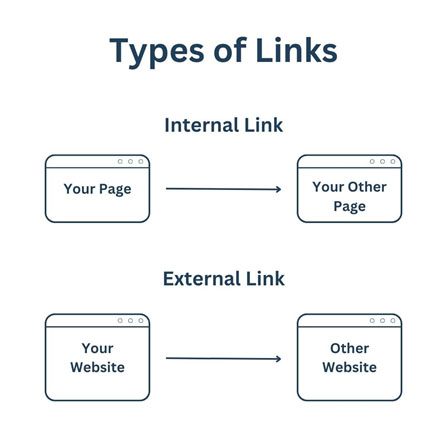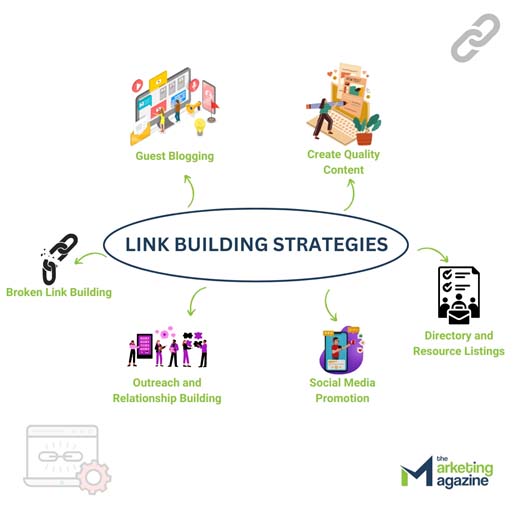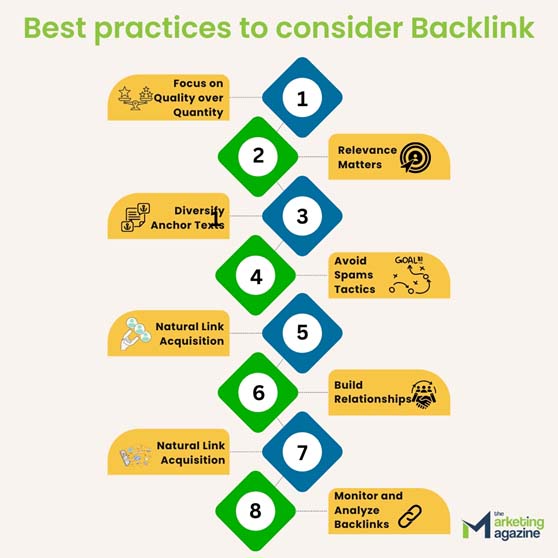Introduction
Definition of Link Building:
Link building refers to the process of acquiring hyperlinks from other websites to your own. These links act as pathways that lead users from one webpage to another across the vast landscape of the internet.
Think of each link as a vote of confidence or recommendation from one website to another. The more links you have pointing to your site from reputable sources, the more authority and credibility your website gains in the eyes of search engines like Google.
Understanding Link Building
Link Building is like building connections on the internet highway to guide traffic to your website. It’s a crucial part of online visibility and SEO, helping your site rank higher in search engine results.
Explanation of Link Building Process:
Think of link building as creating signposts that lead people to your website. When other websites include links to your site, it’s like they’re recommending you to their visitors. This recommendation tells search engines that your website is trustworthy and relevant, boosting your ranking in search results.

Types of Links: Internal vs. External:
Internal Links: These are like pathways within your website, guiding visitors from one page to another. They help users navigate your site and improve its structure.
External Links (Backlinks): These are links from other websites that point to your site. They act as endorsements, signalling to search engines that your content is valuable and authoritative.
Difference Between Backlinks and Internal Links:
Backlinks: Imagine Backlinks as roads leading to your website from other destinations on the internet. They’re like referrals from other sites, boosting your credibility and authority.
Internal Links: These are like pathways within your website’s neighbourhood, guiding visitors from one street to another. They improve navigation and help users explore your content seamlessly.
What are the benefits?
1. Improved Search Engine Rankings:
Imagine your website as a student in a big school. The more friends (links) it has from reputable students (websites), the more popular it becomes. Search engines like Google see these links as votes of confidence, boosting your website’s rank in search results.

2. Increased Website Traffic:
Think of links as road signs directing people to your website. This drives more visitors to your site, increasing your online traffic.
3. Enhanced Domain Authority and Credibility:
Just like having a cool group of friends adds to your street cred, getting links from trustworthy websites boosts your website’s reputation. It tells visitors and search engines that your site is reliable and worth visiting.
What are the strategies?
Here are some simple yet effective strategies to build links:
- Create Quality Content: Start by creating valuable and engaging content that others naturally want to link to. Whether it’s informative blog posts, useful guides, or entertaining videos, good content is the foundation of successful Link Building.
- Guest Blogging: Reach out to other websites in your niche and offer to write guest posts for them. By contributing helpful content to relevant sites, you can earn Backlinks to your own site while also showcasing your expertise.
- Broken Link Building:Find broken links on other websites within your industry and reach out to the site owners with suggestions for replacement links to your own content. It’s a win-win situation—you help them fix their broken links, and they link back to your site.
- Outreach and Relationship Building: Build relationships with influencers, bloggers, and other website owners in your industry. Engage with them on social media, share their content, and collaborate on projects. These relationships can lead to natural link opportunities over time.
- Social Media Promotion: Share your content on social media platforms like Facebook, Twitter, and LinkedIn. When others see your content and find it valuable, they may link to it from their own websites or share it with their audiences, increasing your reach and potential for Backlinks.
- Directory and Resource Listings: Submit your website to relevant online directories and resource listings. While these links may not be as powerful as others, they can still contribute to your overall link profile and help improve your site’s visibility.
Best practices to consider
Building links from other websites to yours, is crucial for improving your website’s visibility and authority in search engine results. Here are some simple and effective best practices for Backlink Building:

1. Focus on Quality over Quantity:
Aim for Backlinks from reputable and relevant websites in your industry. A few high-quality Backlinks hold more value than many low-quality ones.
2. Relevance Matters:
Seek Backlinks from websites that are related to your niche or topic. Relevant Backlinks signal to search engines that your content is valuable and authoritative.
3. Diversify Anchor Texts:
Use a variety of Anchor Texts (the clickable text of a hyperlink) when acquiring Backlinks. This helps search engines understand the context of the linked page and prevents over-optimization.
4. Avoid Spammy Tactics:
Steer clear of black-hat SEO tactics such as buying Backlinks or participating in link schemes. These tactics can result in penalties from search engines and harm your website’s reputation.
5. Natural Link Acquisition:
Focus on creating high-quality content that naturally attracts Backlinks. Shareable and informative content is more likely to earn organic Backlinks from other websites.
6. Build Relationships:
Cultivate relationships with influencers, bloggers, and website owners in your industry. Genuine connections can lead to opportunities for Guest Blogging and earning Backlinks.
7. Stay Active on Social Media:
Share your content on social media platforms to increase its visibility and likelihood of being linked to by others. Social signals can indirectly impact your website’s SEO.
8. Monitor and Analyze Backlinks:
Use SEO tools to monitor your Backlink profile and analyse the quality of your Backlinks. Regularly review and disavow toxic or spammy Backlinks to maintain a healthy link profile.
Tools and resources
When it comes to Link Building, having the right tools and resources can make a significant difference in your success. Let’s explore some of the essential tools and resources you can use to enhance your Link Building efforts in simple, relatable language.
Content Promotion Tools:
Creating great content is just the first step; promoting it effectively is equally important. Content promotion tools like BuzzSumo, Outbrain, and Buffer help you amplify your content’s reach across various platforms.
Think of them as your megaphones in the digital world, helping you get your message out to a wider audience. These tools enable you to share your content on social media, reach out to influencers, and even run paid promotions to maximise exposure.
Outreach and Relationship Management Tools:
Building relationships with other website owners and influencers is crucial for successful link building. Outreach and relationship management tools simplify this process by helping you organise your contacts, track your outreach efforts, and manage your relationships effectively.
Tools like Hunter, Pitchbox, and BuzzStream streamline your outreach campaigns, making it easier to connect with potential link partners. They act as your personal assistants, keeping track of your conversations and ensuring you stay on top of your outreach efforts.
By leveraging these tools and resources, you can take your Link Building efforts to the next level. Whether you’re analysing Backlinks, promoting your content, or reaching out to influencers, having the right tools at your disposal can make the process more efficient and effective. So, arm yourself with these tools, roll up your sleeves, and watch your Link Building efforts soar.
Challenges and their respective solutions of Link Building
In the world of Link Building, there are often hurdles that can make the process challenging. Let’s explore some common obstacles and practical solutions for overcoming them.
1. Limited Resources:
Challenge: Small businesses or individuals may lack the resources, such as time or budget, to execute extensive Link Building campaigns.
Solution: Focus on quality over quantity. Prioritise building relationships with relevant websites and producing high-quality content that naturally attracts Backlinks. Leverage free or low-cost tools for outreach and analysis.
2. Finding Quality Websites:
Challenge: Identifying reputable websites willing to link to your content can be daunting, especially in competitive niches.
Solution: Conduct thorough research to find websites relevant to your industry or niche. Look for opportunities to contribute guest posts, collaborate on content, or participate in industry forums and communities where Backlinks can be earned organically.
3. Competing with Established Brands:
Challenge: Established brands often dominate search engine results, making it challenging for newer or smaller websites to compete for Backlinks.
Solution: Differentiate your content by focusing on unique perspectives, original research, or niche topics. Emphasise your brand’s unique value proposition and build relationships with influencers or industry leaders who can amplify your content.
4. Overcoming Rejection:
Challenge: Facing rejection or non-responsiveness from website owners or editors can be discouraging.
Solution: Stay persistent and resilient. Follow up politely with personalised outreach messages. Use rejection as an opportunity to refine your pitch or improve your content. Remember that each rejection brings you closer to finding the right opportunities.
5. Avoiding Black-Hat Tactics:
Challenge: The temptation to resort to unethical or spammy tactics to acquire Backlinks can jeopardise your website’s reputation and SEO efforts.
Solution: Prioritise white-hat strategies that focus on building genuine relationships and providing value to users. Avoid purchasing Backlinks, participating in link schemes, or engaging in keyword stuffing.
6. Keeping Up with Algorithm Changes:
Challenge: Search engine algorithms are constantly evolving, and what works today may not be effective tomorrow.
Solution: Stay informed about industry trends and algorithm updates. Focus on creating high-quality, relevant content that aligns with search engine guidelines. Diversify your Link Building strategies to adapt to changes in the digital landscape.
7. Measuring Success:
Challenge: Determining the effectiveness of you Link Building efforts and measuring ROI can be challenging without proper tracking and analysis.
Solution: Set clear goals and key performance indicators (KPIs) for your Link Building campaigns. Use tools like Google Analytics and SEO platforms to track Backlink metrics, website traffic, and search engine rankings. Continuously analyse data to refine your strategies and optimise performance.
Conclusion
In conclusion, while Link Building may present challenges, it remains an essential component of digital marketing efforts. By embracing these challenges and implementing best practices, websites can harness the power of Link Building to drive organic growth, improve search engine visibility, and establish themselves as authoritative voices within their respective industries.